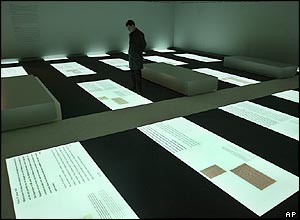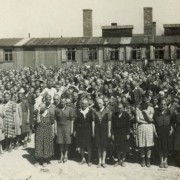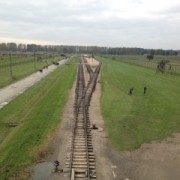Stalin and Hitler as Statisticians
By: Megan Newell
While walking the grounds of Auschwitz-Birkenau, our tour guide recited a simple, yet powerful, quote that has had me lost in thought ever since: the quote reads, “One death is a tragedy, one million is a statistic”. This quote, taken at face value, seems true, in a way. Its truth lies in the idea of emotional attachment; one can be moved by a story of a single death, of a man, woman, or child losing their life. However, it becomes increasingly more difficult to empathize the larger the death toll becomes. With that said, I’m inclined to disagree, almost entirely, with this quote. My problems, or rather oppositions to the quote, lie in the ideology and mentality that helped to form it, as well as the notion that the larger the death toll, the less tragic each death becomes in contrast.

A picture of a building with remnants of a Jewish past engraved in its façade (http://4.bp.blogspot.com)
To start with the background of this quote, it is important to note that Stalin wrote this regarding the Soviet Union during World War II. The Soviet Union, where Josef Stalin himself, only a decade earlier, ordered the induced famine that doomed around 7 million of his own population to death by starvation. This, as a parallel to the Holocaust, (though not to be directly compared) illustrates that death itself is tragic, however the systematic and calculated mass murder of a people is beyond tragic – it’s incomprehensibly inhumane. Both Hitler and Stalin were able to methodically and purposefully murder millions of people without, as I understand it, being consciously aware of the individual lives being exterminated. In this case, it can be understood why Stalin would be inclined to say that a million deaths is a statistic; the high number lends itself to detachment. It allows for the illusion that they are no longer individuals, but rather a statistic, numbers stripped of its connection to an individual being. This shows that the death of millions is not simply a statistic, but rather a multi-faceted and profound tragedy; involving more than just the loss of life, but also the idea that humans are capable of committing such large-scale atrocities against humanity whilst maintaining a level of detachment from the lives of their victims.
Now, regarding the notion that the larger the death toll the less tragic it is as a whole – I wholeheartedly disagree. Three places we have visited – the old Jewish District in Old Town Krakow, the Auschwitz-Birkenau concentration complex, as well as the Memorial to the Murdered Jews of Europe (particularly the Museum located underneath the monument itself)- all show the immensity of the Holocaust whilst illustrating the magnitude of the tragedy itself. Walking through Kazimierz, the Old Jewish District in Krakow, made you realize how prevalent Jewish life was here, how large the community was, and how devastating it is that the whole population was eradicated. In this case, the deaths were not mere statistics at all. By seeing the houses and by imagining daily life, you can begin to empathize with the people and understand on a personal level their lives before the war.
Visiting Auschwitz had an entirely different effect, but all the same, served to prove the fact that every death was in fact tragic. During our six hour tour of the concentration complex I found myself overcome with emotions. The power of the numbers here lied in the ability to individualize each and every death. Over one million people were murdered in Auschwitz – a statistic. However, walking through the barracks, seeing the thousands of shoes that seemed endless, seeing the wall of faces and the book of names makes you truly understand. Understanding that each number, each pair of boots, belongs/belonged to an individual who lost their life here really helped to solidify the idea that these individual lives can’t be reduced to a mere statistic. In fact, there is a profoundness that comes with knowing the numbers and being able to comprehend that each number marks a separate and distinct life lost. The numbers coupled with the individual stories present in some of the rooms of the complex, gives you the kind of understanding you really wish you hadn’t found. In a sense, the experience grounds you; it makes you acutely aware of the doom each and every one of these people faced, rather than simply the collective number of the dead.

One of, and in my opinion one of the most moving, exhibits in the museum that had individual stories and letters from victims, or relatives, of the Holocaust. (http://newsimg.bbc.co.uk)
Finally, visiting the museum under the Monument to the Murdered Jews in Berlin was really something else. The museum, in its entirety, really exemplified the idea that a million deaths are not to be simply described as a statistic. Each exhibit was interactive and gave insight into the lives of quite a few of the victims. Throughout the museum and through different forms, various individuals and families were portrayed, along with their stories and places of death. The stories helped to personalize the victims and give a level of comprehension not received by merely knowing the numbers. This approach is incredibly touching and was a great way to educate and memorialize people who fell victim to these crimes against humanity.











